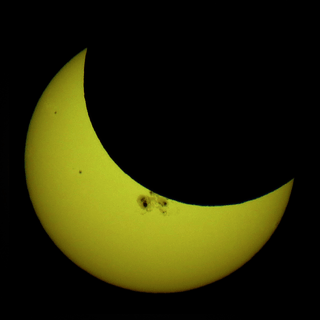Solar eclipse of March 17, 1904
An annular solar eclipse occurred on March 17, 1904, also known as the "1904 St. Patrick's Day eclipse". A solar eclipse occurs when the Moon passes between Earth and the Sun, thereby totally or partly obscuring the image of the Sun for a viewer on Earth. An annular solar eclipse occurs when the Moon's apparent diameter is smaller than the Sun's, blocking most of the Sun's light and causing the Sun to look like an annulus (ring). An annular eclipse appears as a partial eclipse over a region of the Earth thousands of kilometres wide.
| Solar eclipse of March 17, 1904 | |
|---|---|
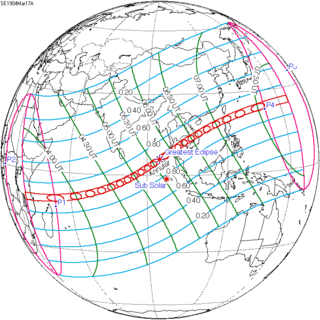 Map | |
| Type of eclipse | |
| Nature | Annular |
| Gamma | 0.1299 |
| Magnitude | 0.9367 |
| Maximum eclipse | |
| Duration | 487 sec (8 m 7 s) |
| Coordinates | 5.6°N 94.7°E |
| Max. width of band | 237 km (147 mi) |
| Times (UTC) | |
| Greatest eclipse | 5:40:44 |
| References | |
| Saros | 128 (52 of 73) |
| Catalog # (SE5000) | 9290 |
Related eclipses
Solar eclipses 1902–1907
This eclipse is a member of a semester series. An eclipse in a semester series of solar eclipses repeats approximately every 177 days and 4 hours (a semester) at alternating nodes of the Moon's orbit.[1]
| Solar eclipse series sets from 1902–1907 | ||||
|---|---|---|---|---|
| Descending node | Ascending node | |||
| 108 | April 8, 1902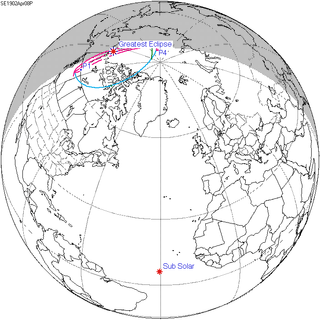 Partial |
113 | October 1, 1902 | |
| 118 | March 29, 1903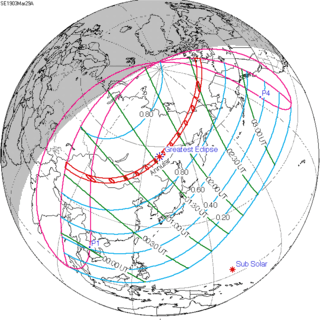 Annular |
123 | September 21, 1903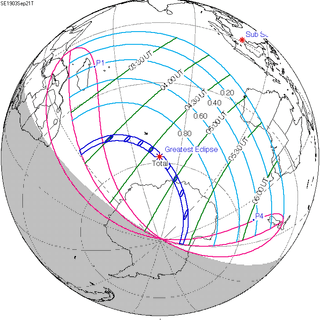 Total | |
| 128 | March 17, 1904 Annular |
133 | September 9, 1904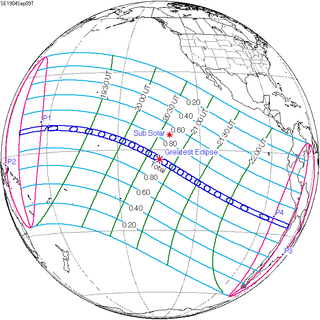 Total | |
| 138 | March 6, 1905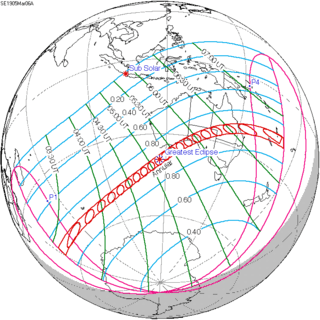 Annular |
143 | August 30, 1905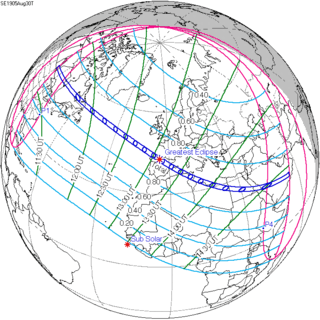 Total | |
| 148 | February 23, 1906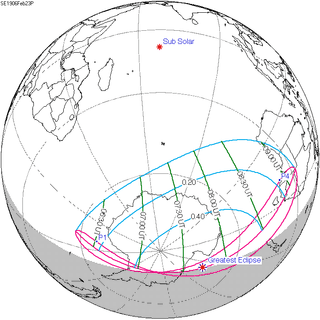 Partial |
153 | August 20, 1906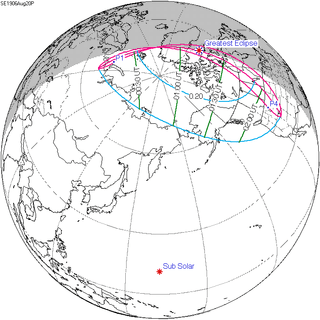 Partial | |
Saros 128
This eclipse is a member of the Solar Saros cycle 128, which includes 73 eclipses occurring in intervals of 18 years and 11 days. The series started with partial solar eclipse on August 29, 984 AD. From May 16, 1417 through June 18, 1471 the series produced total solar eclipses, followed by hybrid solar eclipses from June 28, 1489 through July 31, 1543, and annular solar eclipses from August 11, 1561 through July 25, 2120. The series ends at member 73 as a partial eclipse on November 1, 2282. All eclipses in this series occurs at the Moon’s descending node.
| Series members 52–68 occur between 1901 and 2200 | ||
|---|---|---|
| 52 | 53 | 54 |
 March 17, 1904 |
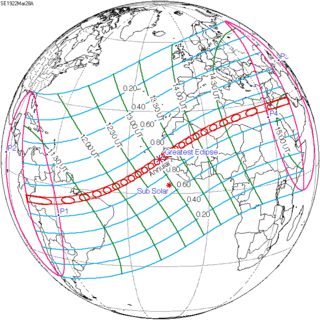 March 28, 1922 |
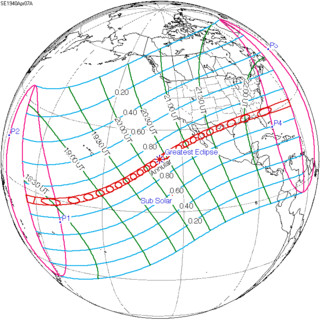 April 7, 1940 |
| 55 | 56 | 57 |
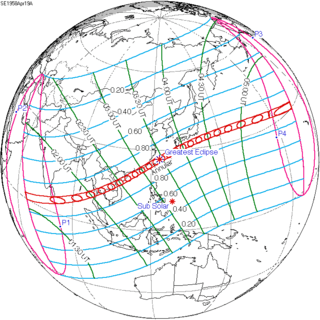 April 19, 1958 |
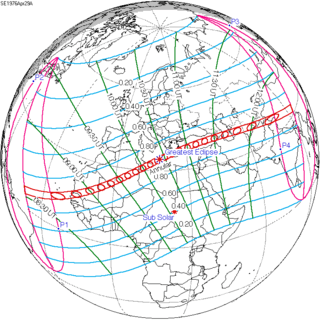 April 29, 1976 |
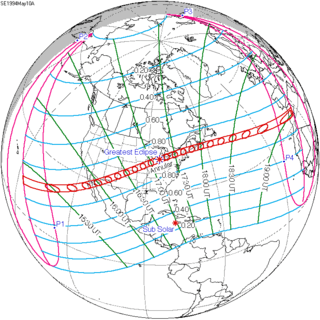 May 10, 1994 |
| 58 | 59 | 60 |
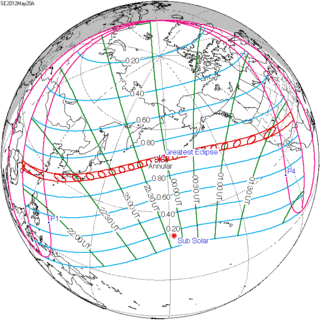 May 20, 2012 |
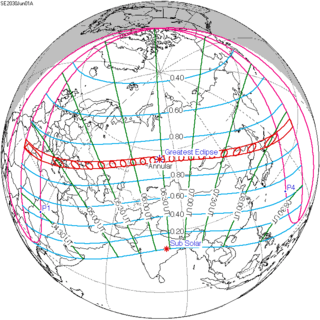 June 1, 2030 |
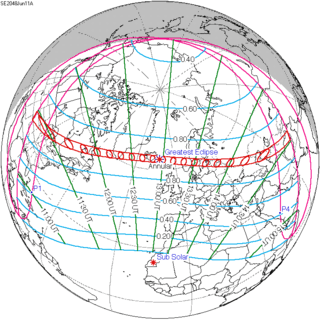 June 11, 2048 |
| 61 | 62 | 63 |
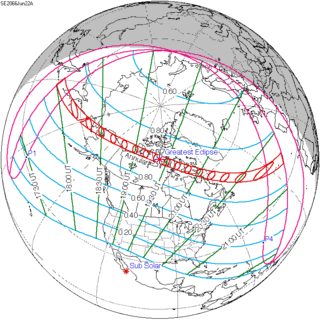 June 22, 2066 |
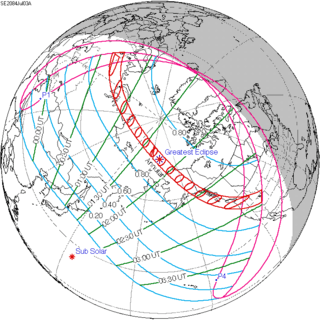 July 3, 2084 |
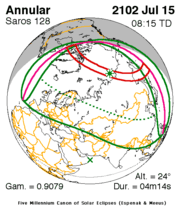 July 15, 2102 |
| 64 | 65 | 66 |
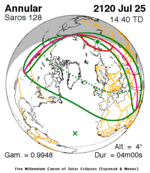 July 25, 2120 |
August 5, 2138 (Partial) | August 16, 2156 (Partial) |
| 67 | 68 | |
| August 27, 2174 (Partial) | September 6, 2192 (Partial) | |
Tritos series
This eclipse is a part of a tritos cycle, repeating at alternating nodes every 135 synodic months (≈ 3986.63 days, or 11 years minus 1 month). Their appearance and longitude are irregular due to a lack of synchronization with the anomalistic month (period of perigee), but groupings of 3 tritos cycles (≈ 33 years minus 3 months) come close (≈ 434.044 anomalistic months), so eclipses are similar in these groupings.
| Series members between 1801 and 2100 | |||
|---|---|---|---|
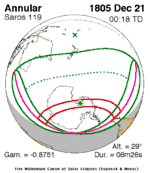 December 21, 1805 (Saros 119) |
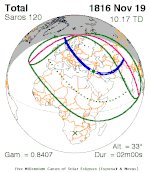 November 19, 1816 (Saros 120) |
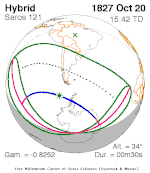 October 20, 1827 (Saros 121) | |
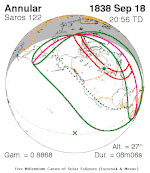 September 18, 1838 (Saros 122) |
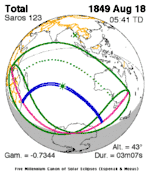 August 18, 1849 (Saros 123) |
 July 18, 1860 (Saros 124) | |
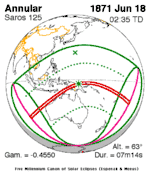 June 18, 1871 (Saros 125) |
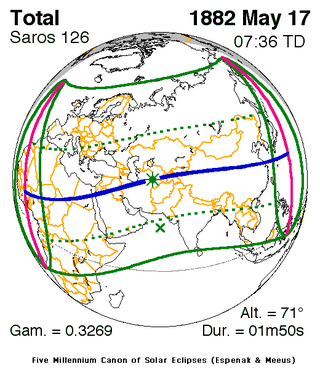 May 17, 1882 (Saros 126) |
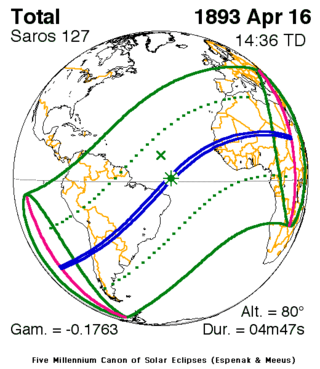 April 16, 1893 (Saros 127) | |
 March 17, 1904 (Saros 128) |
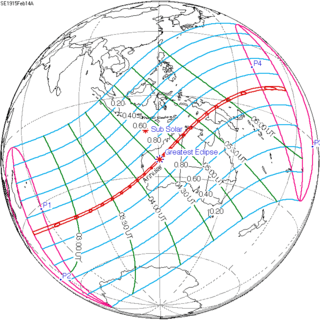 February 14, 1915 (Saros 129) |
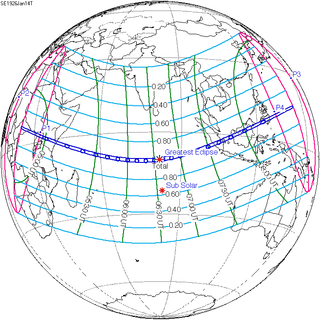 January 14, 1926 (Saros 130) | |
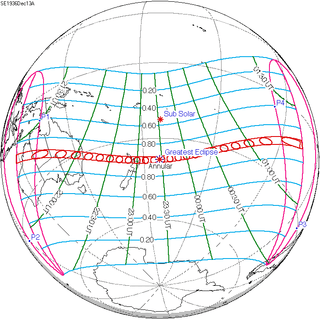 December 13, 1936 (Saros 131) |
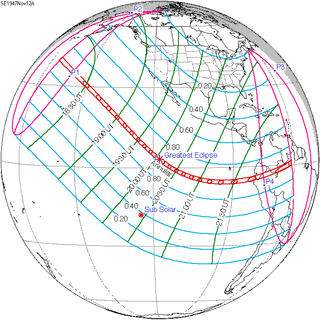 November 12, 1947 (Saros 132) |
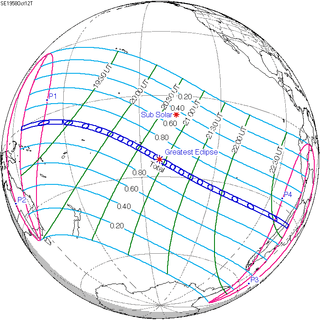 October 12, 1958 (Saros 133) | |
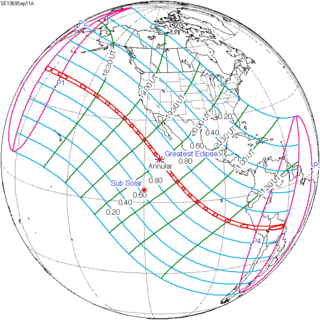 September 11, 1969 (Saros 134) |
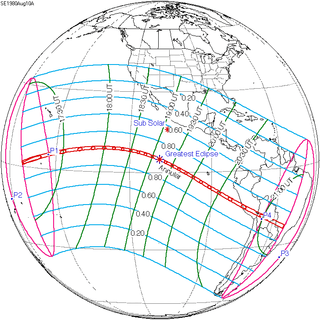 August 10, 1980 (Saros 135) |
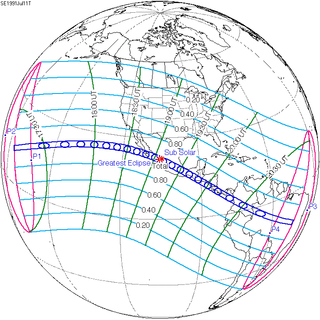 July 11, 1991 (Saros 136) | |
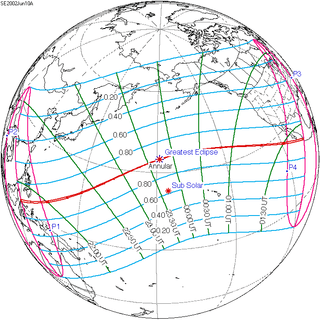 June 10, 2002 (Saros 137) |
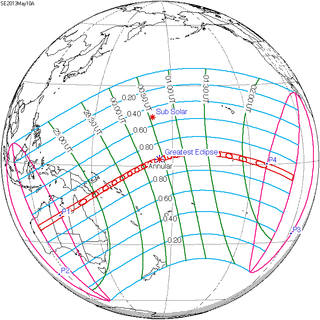 May 10, 2013 (Saros 138) |
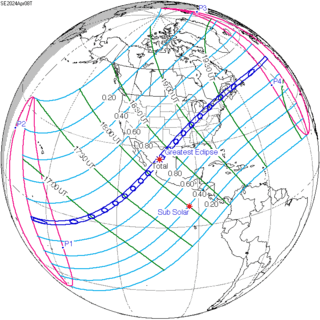 April 8, 2024 (Saros 139) | |
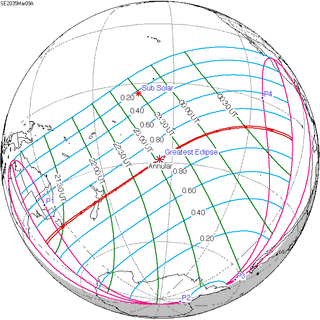 March 9, 2035 (Saros 140) |
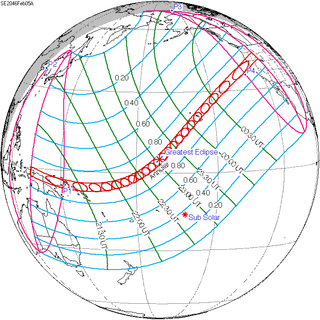 February 5, 2046 (Saros 141) |
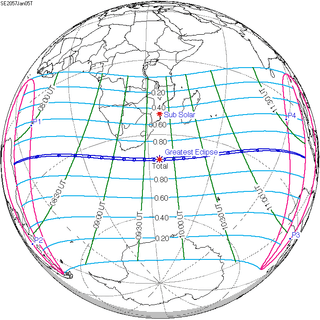 January 5, 2057 (Saros 142) | |
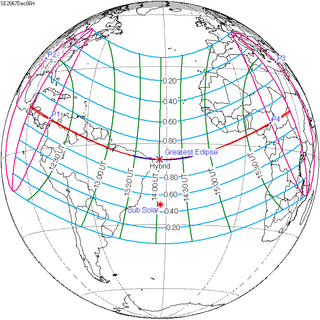 December 6, 2067 (Saros 143) |
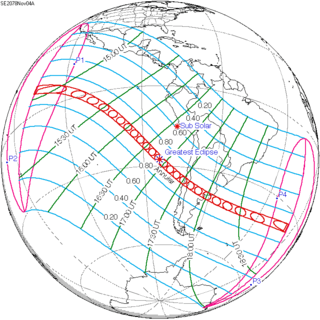 November 4, 2078 (Saros 144) |
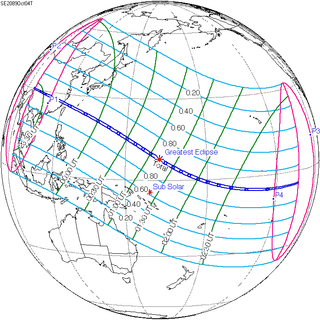 October 4, 2089 (Saros 145) | |
 September 4, 2100 (Saros 146) |
|||
In the 22nd century:
- Solar Saros 147: Annular Solar Eclipse of 2111 Aug 04
- Solar Saros 148: Total Solar Eclipse of 2122 Jul 04
- Solar Saros 149: Total Solar Eclipse of 2133 Jun 03
- Solar Saros 150: Annular Solar Eclipse of 2144 May 03
- Solar Saros 151: Annular Solar Eclipse of 2155 Apr 02
- Solar Saros 152: Total Solar Eclipse of 2166 Mar 02
- Solar Saros 153: Annular Solar Eclipse of 2177 Jan 29
- Solar Saros 154: Annular Solar Eclipse of 2187 Dec 29
- Solar Saros 155: Total Solar Eclipse of 2198 Nov 28
In the 23rd century:
- Solar Saros 156: Annular Solar Eclipse of 2209 Oct 29
- Solar Saros 157: Annular Solar Eclipse of 2220 Sep 27
- Solar Saros 158: Total Solar Eclipse of 2231 Aug 28
- Solar Saros 159: Partial Solar Eclipse of 2242 Jul 28
- Solar Saros 160: Partial Solar Eclipse of 2253 Jun 26
- Solar Saros 161: Partial Solar Eclipse of 2264 May 26
- Solar Saros 162: Partial Solar Eclipse of 2275 Apr 26
- Solar Saros 163: Partial Solar Eclipse of 2286 Mar 25
- Solar Saros 164: Partial Solar Eclipse of 2297 Feb 22
Notes
- van Gent, R.H. "Solar- and Lunar-Eclipse Predictions from Antiquity to the Present". A Catalogue of Eclipse Cycles. Utrecht University. Retrieved 6 October 2018.
.jpg)
